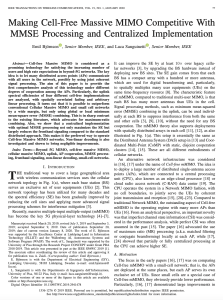
The paper “Making Cell-Free Massive MIMO Competitive with MMSE Processing and Centralized Implementation” that I’ve authored together with Luca Sanguinetti has been awarded the 2022 IEEE Marconi Prize Paper Award in Wireless Communications. This is a great honor that places the paper on the same list as many seminal papers published in the IEEE Transactions on Wireless Communications.
I will take this opportunity to elaborate on five things that I learned while writing the paper. The basic premise is that we analyze the uplink of a system with many distributed access points (APs) that serve a collection of user devices at the same time and frequency. We compared the data rates that can be achieved depending on how deeply the APs are collaborating, from Level 1 (cellular network with no cooperation) to Level 4 (cell-free network with centralized computations based on complete signal knowledge). We also compared maximum ratio (MR) processing of the received signals with local and centralized forms of minimum mean-squared error (MMSE) processing.
I learned the following five things:
- MMSE processing always outperforms MR processing. This might seem obvious, since the former scheme can suppress interference, but the really surprising thing was that the performance difference is large even for single-antenna APs that operate distributively. The reason is that MMSE processing provides much more channel hardening.
- Distributed MR processing is the worst-case scenario. Many of the early works on cell-free massive MIMO assumed distributed MR processing and focused on developing advanced power control algorithms. We demonstrated that one can achieve better performance with MMSE processing and rudimentary power control; thus, when designing a cell-free system, the choice of processing scheme is of primary importance, while the choice of power control is secondary.
- Linear uplink processing is nearly optimal. In a fully centralized implementation, it is possible to implement non-linear processing schemes for signal detection; in particular, successive interference cancellation could be used. We showed that this approach only increases the sum rate by a few percent, which isn’t enough to motivate the increased complexity. The reason is that we seldom have any strong interfering signals, just many weakly interfering signals.
- Distributed processing increases fronthaul signaling. Since the received signals are distributed over the APs, it might seem logical that one can reduce the fronthaul signaling by also doing parts of the processing distributively. This is not the case in the intended operating regime of cell-free massive MIMO, where each AP serves more or equally many users than it has antennas. In this case, fewer parameters need to be sent over the fronthaul when making a centralized implementation!
- Max-min fairness is a terrible performance goal. While a key motivation behind cell-free massive MIMO is to even out the performance variations in the system, compared to cellular networks, we shouldn’t strive for exact uniformity. To put it differently, the user with the worst channel conditions in the country shouldn’t dictate the performance of everyone else! Several early works on the topic focused on max-min fairness optimization and showed very promising simulation results, but when I attempted to reproduce these results, I noticed that they were obtained by terminating the optimization algorithms long before the max-min fairness solution was found. This indicates that we need a performance goal based on relative fairness (proportional fairness?) instead of the overly strict max-min fairness goal.
Since the paper was written in 2019, I have treated centralized MMSE processing as the golden standard for cell-free massive MIMO. I have continued looking for ways to reduce the fronthaul signaling while making use of distributed computational resources (that likely will be available in practice). I will mention two recent papers in this direction. The first is “MMSE-Optimal Sequential Processing for Cell-Free Massive MIMO With Radio Stripes“, which shows that one can implement centralized MMSE processing in a distributed/sequential manner, if the fronthaul is sequential. The paper “Team MMSE Precoding with Applications to Cell-free Massive MIMO” develops a methodology for dealing with the corresponding downlink problem, which is more challenging due to power and causality constraints.
Finally, let me thank IEEE ComSoc for not only giving us the Marconi Prize Paper Award but also producing the following nice video about the paper:

